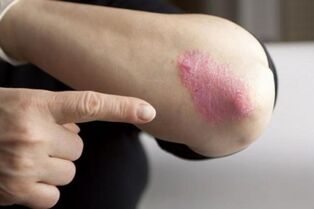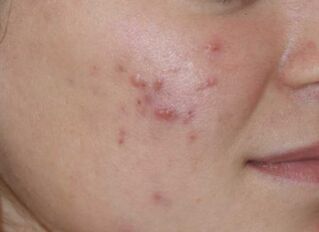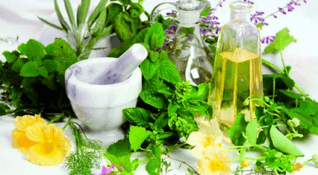In this article we consider the initial stage of psoriasis, what are its causes and the mechanism of formation of the damaged areas. By following our recommendations, you can recognize the symptoms of psoriasis at the initial stage and eliminate them.
Early signs of psoriasis
Patients may have different initial signs of psoriasis. This disease is characterized by an acute onset, rashes occur for a short time. The primary rash is also called a guard or duty rash.
The initial phase lasts several weeks. The duration of this stage of the disease depends on the general condition of the body and its protective capacity.
The rash consists of pale pink to red papules (pimples) that rise above the skin. They are dense to the touch.
After a while you will find silvery whitish flakes that are easy to remove. The skin of the affected areas is inflamed, swollen, redness is noted.
Specialists identify 3 characteristics of psoriasis that distinguish it from other diseases:
| Feature | Feature |
| Stearin staining. | It is a plaque, the scraping of which is accompanied by the appearance of small scales. |
| Psoriatic film. | The last layer that can be removed from the skin after the scales. This layer is similar to plastic wrap. |
| Blood spray or Auspitz phenomenon. | The appearance of drops of blood in violation of the integrity of the psoriatic film. |
The eruptions have different shapes: pointed, drop-shaped, coin-shaped, ring-shaped, diffuse.
In addition to the rash, the patient is concerned about scaling, redness, and itching of varying intensity.
Psoriasis on the elbows

Plaque psoriasis is characteristic of the elbow area. At first, single red papules appear. Then the skin begins to peel off and become rough.
Psoriasis on the legs
First signs: a small rash, inflammation and swelling of the skin. Typical location: knees and feet. Over time, the skin sheds off and the disease begins to progress.
Psoriasis on the hands
The first papules are found in the extensor part of the joints (on the fingers and in the elbow area). Most often, rashes occur on the palms of the hands along with injuries to the feet. Psoriatic arthritis sometimes occurs. It affects joints of various sizes. It is characterized by swelling, redness and deformation of the joint, painful sensations can disturb.
Nail psoriasis
The manifestation of the disease in the nail plate externally resembles a fungal infection. First, longitudinal grooves and sunken points appear along the edge of the nail. The process approaches the root zone of the nail over time. The nail becomes dull and thickened. As the disease progresses, the nail can come off.
Psoriasis on the head
Location of the rash: frontal part, behind the ears and neck area. Papular rashes are accompanied by scaling and itching. Damaged areas are usually damp and cracked. The characteristic symptom is the "psoriatic crown". It occurs when the rash goes beyond hair growth.
Psoriasis on the face
The disease rarely affects the front of the head. Location of the rash: eyelids, nasolabial folds, around the eyes, in the area of the eyebrows, on the cheeks in the form of a fine mesh.

Characteristics of the initial stage of psoriasis in children
To determine if a child has psoriasis, the first thing to look for is redness between the skin folds and the appearance of small pimples (papules) at places of friction with clothing and irritation. The child is restless due to itching and burning.
I need to know! In babies without the necessary examination, the initial stage of psoriasis can be confused with allergic manifestations, diathesis, itching, diaper rash. A distinctive feature of psoriasis is the presence of a clear border.
It should be noted that congenital psoriasis in children is characterized by more pronounced clinical manifestations from the moment of birth.
Children with weak immunity after a severe infection are at risk for psoriasis. Special attention should be paid to children whose parents have psoriasis.
Mechanism of psoriatic plaque formation
Psoriasis spots are areas where an inflammatory reaction occurs and the excessive formation of keratinocytes (epithelial cells) occurs. In this case, an excessive number of capillaries is formed in the dermis. Infiltration (soaking) of the damaged skin with lymphocytes and macrophages leads to its thickening and elevation. As a result, pale gray spots form that look like hardened wax.
Important! Normally, the epidermis is renewed every 30 days. With psoriasis, the duration of this process is significantly reduced. Cell division, maturation, and death in this disease occur in just 5 days. Due to the pathological speed, communication between cells is lost.
Causes of occurrence
Experts identify several provoking factors:
- Hereditary predisposition.It is assumed that genetic malfunction occurs in the human body, leading to increased keratinization.
- Disruption of the immune systemleading to increased production of lymphocytes (T cells) and inflammation. An autoimmune reaction is not excluded - damage to one's cells and tissues as a result of their perception as strangers.
- Endocrine pathology,metabolic disorders.
- Disease of the nervous system.
- Excessive psycho-emotional stress, stress.This factor is a trigger for the development of the disease and also contributes to its exacerbation. During a stressful situation, the body releases hormones and a series of biochemical reactions, leading to the appearance of rashes and scales.
- Consume alcohol,drugs, smoke tobacco products.
I need to know!Children whose parents have psoriasis are at higher risk of developing the disease.
Disease diagnosis
If you suspect you have psoriasis, see your dermatologist. As a rule, after external examination and an assessment of the condition of damaged areas of the skin, make a diagnosis. In rare cases, when doubts and difficulties arise in the diagnosis, the doctor prescribes additional research methods. These include:
- Skin biopsy: A procedure to take a sample of damaged skin. Helps identify changes at the cellular level.
- Blood test.Helps to identify the presence of inflammation and exclude other diseases.
- X-ray of the joints.It is used exclusively for joint pain in order to exclude the development of psoriatic arthritis.
- Bacteriological cultureof the pharynx. It is prescribed to confirm the tear-shaped form of psoriasis and to exclude acute pharyngitis.
- Potassium hydroxide test.Helps eliminate fungal infections.
Disease treatment
Unfortunately, today there is no way to cure the disease. Therefore, the main goal of therapy - the elimination of symptoms and the relief of relapses with an increase in the time of remission (the time interval for the weakening and disappearance of the symptoms of the disease). Therefore, treatment must be comprehensive and long-term.
After making a diagnosis, determining the stage and severity of the disease, the dermatologist chooses the necessary treatment methods. Before starting therapy, the patient's diet and lifestyle are adjusted. All possible factors provoking an exacerbation of the disease are excluded without fail.
In the initial stage, the doctor may prescribe:
| Drug group | Drug name | Expected effects and characteristics of the treatment. |
| Keratolytics | Betamethasone. | Improves exfoliation. |
| Vitamins | Derivatives of vitamin D3 or A. | Improves the general condition of the body and skin. |
| Local non-hormonal preparations with anti-inflammatory effect | Clemastine, Promethazine Hydrochloride. | Eliminates inflammation, redness and swelling. |
| Tar Ointments | Coal Tar Oil Extract | Improves healing. |
| Media containing solidol | Has a positive effect on healing, eliminates itching. | |
| Salicylic acid ointments | Salicylic acid | Accelerates healing and promotes scabbing. |
In the initial stage, do not use aggressive drugs. Drugs should be for external use, the doctor prescribes oral administration in case of a severe course of the disease.
In addition to pharmacological treatment, specialists prescribe physiotherapy procedures:
- UFO (ultraviolet radiation).
- Baths: paraffin, radon, sulfur.
- Hirudotherapy.
Traditional treatment methods
At home, it is possible to use folk recipes for treatment. It should be carried out exclusively in combination with the main treatment prescribed by a dermatologist, and only after consulting a doctor.
There are many recipes aimed at improving the general condition of the body, as well as topical means to eliminate the external manifestations of the disease. A series of linseed oil, celandine, calendula ointment has a good effect.

Consider the most popular recipes for alternative treatments:
Ointment for psoriasis
Ingredients:
- St. John's Wort - 20
- Celandine (root herb) - 20 g.
- Propolis - 20 g.
- Calendula -10 years
- Vegetable oil - 10 g.
How to cook:Mash all plants until soft. Then add vegetable oil and mix well. Store in a cool dark place.
How to use:Lubricate the affected skin 2-3 times a day.
Result:the herbal ointment will help eliminate inflammation.
Egg Ointment
Ingredients:
- Chicken eggs - 2 pcs.
- Sunflower oil - 1 tablespoon
- Acetic acid - 40 g.
How to cook:Beat the eggs and butter. Then add acetic acid to the resulting mass and mix well.
How to use:lubricate the affected skin once a day at night.
Result:An effective remedy eliminates the initial signs of psoriasis, reduces swelling, redness and helps to reduce the rash.
Herb decoction
Ingredients:
- Sea buckthorn - 10 years
- Tansy flowers - 10 g.
- Chamomile flowers - 15 g.
- Vodka - 50 g.
- Sea buckthorn oil - 10 g.
- Water - 1 glass.
How to cook:cut all the plants. Then pour boiling water and boil for 5 minutes. After that, let the broth infuse for 40 minutes. Then strain and add vodka, sea buckthorn oil and mix well.
How to use: Take the decoction once a day. To do this, dilute the product: 3 drops per 0. 3 cups of warm boiled water. Diluted broth - 1 tbsp. l for the same amount of water, rub once a day on damaged skin.
Result:the broth eliminates rashes and inflammation, when taken orally, it has a general strengthening effect on the body.
Diet
Proper nutrition is the key to your health. A properly selected diet will help prevent the exacerbation of psoriasis. An individual meal is prepared for each patient.
Be sure to exclude from your diet:
- Alcohol and tobacco products.
- Coffee.
- Chocolate.
- Smoked meats and spicy foods.
- Preservatives and carbonated drinks.
Also, limit the use of flour products, sweets.
Your meal must be complete and meet your energy needs. Nutritionists recommend including the following foods in your diet:
- Fermented dairy products.
- Vegetable oils.
- Fresh vegetables and fruits.
- Oatmeal porridge.
Question-answer
What fat is used for psoriasis?
For this purpose, you need a medical solidol, which is sold in pharmacies. The agent is most effective in its pure form without additives.
Can psoriasis be treated with traditional medicine?
It is possible, but only in combination with traditional methods and after consulting a doctor about it. Salt baths have a good effect (sea salt is used). They help eliminate inflammation from chamomile or string bath. The itchiness will help eliminate the juniper infusion. In the initial stages, rubbing with oatmeal helps remove flaking.
Is psoriasis contagious?
The answer is no: psoriasis is not contagious. The infectious origin of the disease has been completely disproved.
Does your hair fall out with psoriasis?
If psoriasis is not combined with other diseases that cause hair loss, this does not happen. Hair loss is not seen in most patients.
What makes psoriasis worse?
The disease has periods of improvement and exacerbation. Knowing the factors that aggravate the condition will increase the time that its manifestations will not bother you. There are a few possible reasons for the deterioration, so they should be considered and remembered:
- Skin damage and scratches.A very common symptom of psoriasis is itching and burning. Combing the damaged areas aggravates the situation.
- Sunbeams.The sun's rays, when exposed to moderate skin, are beneficial. But at the same time, tanning can trigger the development of psoriasis.
- Stress.Some patients indicate that after nervous tension the manifestations of psoriasis worsen.
- Multiple infections.They disrupt the body's defense system and weaken it.
- Diet.A healthy and correct diet is essential to treat the disease. But if it is violated, patients notice a worsening of their condition. Especially if you drink alcohol and smoke unlimited amounts of tobacco.
Can I remove the scales myself?
No way! You cannot remove the scales on your own. This can cause aggravation and discomfort.
What to remember
- Psoriasis is a chronic disease with periods of improvement and exacerbation.
- There is currently no cure for the disease. Treatment consists of relieving symptoms and increasing periods of remission (when psoriasis symptoms do not appear).
- The initial stage of the disease is best treated, so if the first signs appear, consult a dermatologist.
- Children whose parents have psoriasis are more likely to develop the disease.























